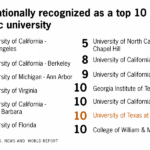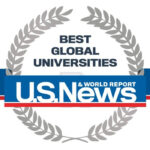University rankings significantly impact higher education globally. These metrics, often compiled by organizations like Times Higher Education and QS, influence student applications, university funding, faculty recruitment, and even national competitiveness. Understanding the methodologies, biases, and long-term effects of these rankings is crucial for navigating the complex landscape of modern academia.
This analysis delves into the multifaceted influence of university rankings, examining their impact on various stakeholders – from prospective students weighing their options to university administrators strategizing for improved positions. We will explore the methodologies employed by ranking organizations, the ethical considerations surrounding their use, and the long-term consequences for institutional development. The goal is to provide a balanced perspective, acknowledging both the benefits and drawbacks of this pervasive system.
The Impact of University Rankings on Student Applications
University rankings exert a significant influence on student application patterns, acting as a powerful signal for prospective students navigating the complex landscape of higher education choices. The perceived prestige and quality associated with a high ranking often translate directly into increased application numbers, creating a competitive environment among institutions. This influence, however, is not static; it’s a dynamic relationship shaped by various factors and subject to shifts over time.
The correlation between a university’s ranking and the number of applications it receives is generally positive and quite strong. Higher-ranked universities typically receive a significantly larger volume of applications than lower-ranked ones. This is partly due to the perception of enhanced educational quality, better career prospects, and increased networking opportunities associated with prestigious institutions. However, it’s important to note that this correlation is not absolute; factors such as program-specific reputation, location, cost, and financial aid packages also play crucial roles in a student’s decision-making process. For example, a highly ranked university with prohibitively high tuition fees might see fewer applications than a slightly lower-ranked institution offering generous financial aid.
Ranking Changes and Application Trends
Changes in a university’s ranking position directly impact its application volume. A rise in ranking often leads to a surge in applications the following year, as the improved standing attracts more attention from prospective students and their families. Conversely, a drop in ranking can result in a decrease in applications, though the magnitude of this effect can vary depending on the size of the drop and other contextual factors. For instance, a consistent decline in ranking over several years might have a more pronounced impact than a single-year dip. The University of California, Berkeley, for example, experienced a slight dip in applications following a minor decrease in its global ranking, but this was quickly offset by a strong emphasis on research opportunities and its established reputation.
Strategies for Improving Ranking Positions and Attracting Applicants, University rankings
Universities employ various strategies to enhance their ranking positions and, consequently, attract a larger pool of applicants. These strategies often involve a multi-pronged approach focusing on improving research output, faculty quality, student selectivity, and overall institutional reputation. Many institutions invest heavily in research infrastructure and actively encourage faculty to pursue grants and publish in high-impact journals. They also focus on attracting and retaining top-tier faculty through competitive salaries and benefits packages. Furthermore, strengthening admission standards, aiming for a more selective student body, and improving student support services are all considered key components of this strategy. These actions are often intertwined; for example, a strong research reputation can attract top faculty, leading to higher quality teaching and attracting more qualified applicants, thus further strengthening the ranking position in a positive feedback loop.
Methodology of University Ranking Systems
University ranking systems, while influential, employ diverse methodologies, leading to variations in results and raising questions about their comprehensive nature. Understanding these methodologies is crucial for interpreting rankings effectively and recognizing their limitations. Different organizations prioritize different metrics and employ varying weighting schemes, impacting the overall ranking outcomes.
The methodologies of prominent ranking organizations like Times Higher Education (THE) and QS World University Rankings differ significantly, reflecting distinct philosophical approaches to evaluating higher education institutions. Both consider a range of factors, but the relative importance assigned to each metric varies considerably, leading to different university placements.
University rankings serve as a valuable, albeit imperfect, tool for prospective students. A prominent example is found when examining the Rice University US News Rankings & , which often influences application decisions. Ultimately, however, the best university for any individual depends on factors beyond any ranking system’s scope.
Key Metrics Used in University Rankings
The selection and weighting of metrics significantly influence the final ranking. Both THE and QS incorporate factors related to teaching, research, citations, industry income, and international outlook. However, the specific indicators used and their weighting differ substantially. For instance, THE places a strong emphasis on research citations and the overall research environment, while QS gives greater weight to academic reputation and employer reputation surveys. This difference highlights the inherent subjectivity in the ranking process. Furthermore, the data collection methods employed by each organization can introduce further variations.
Comparison of THE and QS Methodologies
A direct comparison reveals key distinctions. THE’s methodology is more research-focused, with a larger proportion of points allocated to research output, citations, and research income. Conversely, QS gives more weight to reputation surveys, both among academics and employers. This difference reflects differing perspectives on what constitutes a “good” university – a research powerhouse versus a highly regarded institution with strong industry connections. The reliance on reputation surveys, while providing valuable insights into perceived quality, also introduces potential biases influenced by prevailing perceptions and geographic factors.
Limitations and Biases in University Ranking Systems
Several inherent limitations and biases affect the reliability and objectivity of university rankings. The reliance on easily quantifiable metrics can overlook crucial aspects of university quality, such as student experience, teaching quality beyond research output, and the overall learning environment. Furthermore, the weighting schemes employed are often not fully transparent, hindering a complete understanding of the ranking process. Geographic biases can also arise, with universities in certain regions or countries potentially advantaged due to the way data is collected or interpreted. For example, universities in countries with strong research funding and established research networks may inherently score higher in metrics related to research output and citations. Finally, the focus on easily quantifiable data can lead to an overemphasis on certain aspects of university performance while neglecting others that are more qualitative and harder to measure. These limitations underscore the need for a nuanced interpretation of university rankings, considering them as one factor among many when making decisions about higher education.
University rankings often influence prospective students’ choices, reflecting a complex interplay of academic reputation, research output, and student experience. Staying informed about a university’s progress is crucial, and for Monmouth University, you can find the latest developments by checking out their news section: Monmouth University News Recent Updates. Understanding these updates can provide a more nuanced perspective when evaluating university rankings and making informed decisions.
The Influence of Rankings on University Funding and Resources
University rankings exert a significant influence on the financial health and stability of higher education institutions. A university’s position in global or national rankings directly impacts its ability to secure funding from various sources, ultimately shaping its capacity for research, infrastructure development, and overall academic excellence. This influence operates through complex mechanisms, affecting both public and private funding streams.
University rankings significantly impact government funding decisions. Governments often use ranking metrics as one factor among many when allocating public funds to universities. Higher-ranked institutions frequently receive preferential treatment, leading to increased funding for research grants, infrastructure improvements, and student scholarships. This is because governments often view high rankings as an indicator of institutional quality and national prestige. For example, a country might prioritize funding universities that consistently rank highly in international indices, perceiving them as key contributors to national competitiveness and innovation. Conversely, universities experiencing a decline in ranking may face budget cuts or reduced funding allocations as governments reassess their investment priorities. This can create a self-reinforcing cycle, where decreased funding hinders a university’s ability to improve its academic standing and attract top faculty and students, further impacting its ranking.
Government Funding Allocation Based on Ranking
Government funding bodies often incorporate ranking data into their complex algorithms for resource distribution. While not the sole determinant, a high ranking can significantly increase a university’s chances of securing larger grants for research projects, capital improvements (such as new buildings or laboratory equipment), and operational expenses. Conversely, a consistent decline in ranking might trigger a review of allocated funding, potentially leading to reductions in budgetary support. This pressure to maintain high rankings can incentivize universities to prioritize metrics favored by ranking systems, sometimes at the expense of other important aspects of higher education.
Private Donations and Investments Attracted by High Rankings
High rankings act as a powerful magnet for private donations and investments. Philanthropists and private investors often view top-ranked universities as safer and more effective investments, expecting a higher return on investment in terms of research outcomes, alumni success, and overall institutional prestige. For example, a university consistently ranked among the top ten globally might attract significant endowments from alumni, corporations, and foundations seeking to associate themselves with a prestigious institution. This influx of private funding can be crucial for supporting scholarships, building new facilities, and attracting top faculty members, further enhancing the university’s competitiveness and reinforcing its high ranking. A drop in ranking, however, can significantly diminish a university’s attractiveness to potential donors and investors, potentially resulting in a decrease in private funding.
Consequences of Ranking Decline on Financial Stability
A decline in university rankings can have serious consequences for a university’s financial stability. Reduced government funding, decreased private donations, and a potential decline in student applications (leading to lower tuition revenue) can create a financial crisis. The resulting budget constraints may force universities to make difficult decisions, such as reducing staff, cutting academic programs, or delaying infrastructure projects. This can trigger a vicious cycle, where a decline in resources further hinders the university’s ability to improve its academic standing and attract students and faculty, leading to a further decline in ranking and exacerbating financial instability. The financial pressures associated with maintaining a high ranking can also lead to ethical concerns, such as prioritizing certain metrics over others, or engaging in practices that artificially inflate rankings.
University Rankings and Faculty Recruitment
University rankings exert a significant influence on the academic job market, shaping the strategies of both institutions and prospective faculty members. A high ranking often translates into a more attractive recruitment proposition, impacting the quality and diversity of faculty a university can attract. This section explores the multifaceted relationship between university rankings and faculty recruitment, highlighting both the advantages and potential drawbacks.
The role of university rankings in attracting top faculty members is undeniable. Top scholars, particularly those in highly competitive fields, often prioritize institutional prestige and reputation when considering job offers. A prominent position in global or national rankings serves as a strong indicator of a university’s research output, funding opportunities, and overall academic standing. This makes highly-ranked institutions more appealing to candidates seeking to advance their careers and contribute to a vibrant research environment.
University Ranking’s Influence on Recruitment Strategies
Many universities strategically leverage their ranking in recruitment materials and outreach efforts. For instance, marketing materials often prominently display a university’s ranking position, emphasizing its prestige and global recognition. This is particularly effective when targeting international candidates who may be less familiar with the nuances of a specific national higher education system. Furthermore, institutions often use their ranking as a selling point during faculty recruitment events and interviews, highlighting the resources and collaborative opportunities available within a highly-ranked environment. For example, a university might emphasize its access to state-of-the-art facilities, extensive research funding, and a supportive network of established scholars, all of which are often correlated with higher rankings.
Potential Downsides of Over-emphasizing Rankings in Faculty Recruitment
While rankings can be a valuable asset, over-reliance on them in faculty recruitment carries potential risks. An overemphasis on rankings might lead to a narrow focus on metrics that don’t necessarily reflect the quality of teaching or the overall academic experience. This could potentially attract candidates primarily driven by prestige rather than a genuine commitment to teaching and mentoring students. Furthermore, focusing solely on highly-ranked institutions might create an imbalance in the distribution of talented faculty, potentially disadvantaging institutions that may offer equally strong research opportunities but lack the same ranking recognition. This could exacerbate existing inequalities within the higher education landscape. Finally, an overemphasis on rankings could lead to a pressure-cooker environment, where faculty are unduly pressured to prioritize research output solely for the purpose of improving the institution’s ranking, potentially compromising the quality of their teaching and mentoring.
Student Perceptions and the Value of University Rankings
University rankings exert a considerable influence on prospective students’ college selection process, shaping their perceptions and expectations regarding higher education institutions. While rankings provide a seemingly objective measure of university quality, their impact is complex and multifaceted, varying significantly depending on individual student priorities and backgrounds.
The utilization of university rankings by prospective students is widespread, often serving as a preliminary screening tool to narrow down a vast pool of potential universities. Many students, particularly those from less familiar backgrounds with higher education, rely heavily on these rankings to gauge the prestige and overall quality of an institution. This reliance stems from the perceived ease of understanding and comparing institutions based on a single, numerical score. However, the significance attributed to these rankings varies considerably.
The Diverse Importance of Rankings to Prospective Students
The weight students place on university rankings is far from uniform. Some students prioritize rankings as a primary factor, viewing a higher ranking as a direct indicator of better academic opportunities, career prospects, and overall educational experience. For these students, a prestigious ranking can be a crucial factor in their decision-making process, potentially overshadowing other considerations. Conversely, other students view rankings with a degree of skepticism, recognizing their limitations and focusing instead on factors like specific program quality, faculty expertise, research opportunities, campus culture, location, and affordability. These students may use rankings as one piece of information among many, rather than as the sole determinant of their college choice. A significant portion of students fall somewhere between these two extremes, considering rankings as one factor among several others, weighting its influence alongside other crucial aspects of the university experience.
Comparative Analysis of Student Choices
Students’ college choices often represent a complex interplay between ranking position and other crucial factors. For example, a highly ranked university located in a remote or expensive area might be less appealing to a student prioritizing proximity to family or affordability. Similarly, a student with a specific career goal might prioritize a university renowned for its specialized program, even if its overall ranking is lower than other institutions. A comparative analysis reveals that while rankings can influence decisions, they rarely act in isolation. Consider a hypothetical scenario: Student A, focused on a career in engineering, might choose a university with a top-ranked engineering program but a lower overall ranking over a university with a higher overall ranking but a weaker engineering department. Student B, prioritizing research opportunities, might choose a smaller, less highly ranked university with renowned faculty in their field of interest over a larger, higher-ranked institution with less individualized research support. These scenarios highlight the dynamic and nuanced nature of student decision-making, demonstrating the contextual importance of university rankings within the broader landscape of college selection criteria.
Visual Representation of Ranking Data
University rankings, while often debated, provide a concise, albeit imperfect, snapshot of institutional performance. Visualizing this complex data effectively allows for quick comparisons and identification of trends across different ranking systems. A simple table can effectively communicate the relative standing of institutions.
The following table presents a comparison of the rankings of five leading universities across three prominent ranking systems. It’s important to note that the rankings themselves are subject to the methodologies employed by each system, leading to potential variations. These discrepancies highlight the limitations of relying solely on a single ranking system for comprehensive evaluation.
University Rankings Across Three Systems
| University Name | QS World University Rankings | Times Higher Education World University Rankings | Academic Ranking of World Universities (ARWU) |
|---|---|---|---|
| Massachusetts Institute of Technology (MIT) | 1 | 2 | 1 |
| Stanford University | 2 | 1 | 2 |
| Harvard University | 3 | 3 | 3 |
| University of Cambridge | 4 | 4 | 6 |
| California Institute of Technology (Caltech) | 5 | 5 | 4 |
In conclusion, university rankings present a complex and often controversial aspect of the higher education landscape. While they serve as valuable benchmarks for prospective students and a source of prestige for institutions, their influence extends far beyond simple numerical comparisons. A critical understanding of their methodologies, biases, and ethical implications is essential for both universities and students to make informed decisions and foster a more equitable and transparent higher education system. The long-term effects of focusing solely on ranking improvements warrant careful consideration, highlighting the importance of a balanced approach that prioritizes holistic institutional development.




